The skin and coat of the cat
A shiny coat is considered a sign of health in the cat. Your cat thinks so too: as much as 25% of their waking time is spent on coat care! This amounts to about two to three hours per day. Hair loss, tangles, dandruff, a dull or greasy coat, or dry skin are also signs that your cat is not feeling well in its skin. Pharmacy4pets is happy to help you keep your cat's skin and coat healthy and shiny.
The Skin of the Cat
The skin is the largest organ of the body and has many functions. First and foremost, a cat's skin forms a barrier between the body and the outside world, protecting the body from pathogens, dehydration, and injuries. Additionally, the skin plays an important role in maintaining body temperature. The skin also fulfills several important tasks, such as the storage of moisture, salts, and fat, and the production of hormones and pigments. In most cats, almost all of the skin is covered with hair. The position of the hairs plays a role in the body language of the cat, think of getting a bushy tail when threatened.
Shedding in Cats
As temperatures rise and days lengthen, your cat exchanges its thick winter coat for a lighter summer coat. This can be accompanied by a lot of hair loss. In indoor cats, the seasonal shedding may give way to a more constant shedding throughout the year. Nearly all cat owners sometimes get annoyed by this hair loss, which literally leaves traces in the house. By regularly brushing your cat, you can help limit this. Brushing is good for the hair, the coat, and the skin.
Reducing hair loss is not always possible, but a starting point can be to first look closely at the diet: your cat's hair grows all year round. The normal, healthy skin renews itself every three to six weeks, thereby setting high demands on the diet. About a third of the daily protein requirement is used, for example, for the maintenance of your cat's skin and coat. A balanced and complete diet provides the necessary nutrients to support hair growth and contributes to a healthy coat and skin. Yet, there is sometimes a need for certain vitamins, amino acids, fatty acids, or minerals. During shedding, it can certainly be useful to supplement the diet with supplements like Biomethin+ or Formel Z, supplements with extra B-vitamins. Dermazyme Zinc provides extra zinc. Essential fatty acids can be supplemented in liquid form, such as Megaderm, or in capsules, for example, Vetoquinol Care omega 3-6.
Excessive Shedding
Of course, you want your cat's coat to look healthy and shiny. Therefore, it can be quite concerning to see your cat suffering from hair loss. While a bit of shedding is completely natural, excessive hair loss, even leading to bald spots, can indicate a more serious problem with your cat. A few possible causes of hair loss include:
- Deficiencies in certain vitamins, minerals, fatty acids, or amino acids.
- Hormonal disorders.
- Parasitic infections.
- Ringworm (fungus).
- Genetic predisposition.
- Allergy.
Besides optimizing the diet, it is important to determine the cause of the hair loss. If your cat develops bald spots or a thin coat, it is advisable to consult your veterinarian.
Skin Problems in Cats
In addition to hair loss, your cat may also suffer from a greasy or dull coat, dandruff, crusts, itching, dry skin, or tangles. The most common causes of skin or coat problems in cats are:
Fleas
Fleas are still incredibly common and are the number one cause of itching in cats. A flea allergy is the most common allergy in cats. Fleas can cause itching all over the body. In cases of allergic reactions, itching most commonly occurs on the head and neck, and on the lower back. Monthly flea control with products such as Advantage or Vectra Felis is essential in controlling itchiness caused by these little critters.
Poor Coat Care
Although coat care is a very important part of a cat's daily routine, sometimes things go wrong. Especially in older cats with conditions like chronic kidney disease or arthritis, or in overweight cats, we often see that the cat's coat becomes poorly maintained. Due to pain, insufficient energy, or simply because they can't reach properly, the cat no longer grooms itself. The result is often a greasy coat with tangles or even a matted coat. Besides possible pain management and weight loss, it is necessary for the owner or a professional cat groomer to maintain the coat. If combing and brushing do not work, having the cat shaved once or twice a year can often be a good solution.
The Dandruff Mite
A greasy coat with dandruff can be caused when the sebaceous glands produce too much oil (sebum). These oils nourish and protect the skin, but in excessive amounts, they can irritate your cat's skin, leading to dandruff and more hair loss than normal. Dandruff can also occur with less than adequate coat care. Additionally, the Cheyletiella mite, also known as the dust or dandruff mite, causes dandruff with or without itching. Cheyletiella can be treated with a spot-on product available from the veterinarian.
Allergies
Cats, like humans, can be allergic to things in their diet or environment. The most common allergy in cats, as mentioned, is the flea allergy. To have itchiness all year round, a cat only needs to be bitten by a flea once every two to three weeks! We also see food allergies and environmental allergies (such as pollen or dust mites), also known as atopy, in cats. In the case of allergies, itching is the primary symptom. Depending on what the cat is allergic to, treatment consists of good flea control, special hypoallergenic diet food like Sanimed Skin Sensitive, or anti-inflammatory medication.
Ringworm
Ringworm is the common name for a fungal infection. The name comes from the typically ring-shaped bald spots that this fungal infection causes. But it's not a worm! A fungal infection in cats often causes bald spots with dandruff, with or without itching. Sometimes cats show no symptoms but still spread fungal spores, which can infect other cats and their owners. Fungus is also transmissible to humans. Therefore, timely diagnosis and thorough treatment are important.
Excessive Grooming
In grooming, your cat removes parasites, dead hair, dirt, and other irritating substances from its coat. If your cat licks the same spot repeatedly, you will eventually notice that the spot becomes balder or the quality of the hair deteriorates. Excessive grooming behavior can also lead to the formation of hairballs due to the ingestion of loose hairs.
Excessive grooming is often a sign of itching. Licking one specific area can also indicate pain. For example, cats with a urinary tract infection often lick their belly bald. Licking can also be a symptom of stress or boredom: if your cat is not (or is overly) stimulated by its environment, it may groom its coat more than necessary.
Supporting the Skin and Coat of Cats with Skin Problems
For cats with skin and coat problems, it's important to visit the veterinarian for an accurate diagnosis and possible treatment. Additionally, as an owner, you can do a lot to support your cat's skin and coat as best as possible. Previously mentioned supplements with B-vitamins, amino acids, minerals, and fatty acids are very helpful in supporting healthy skin and coat. In animals with skin problems, the skin's barrier function is often disrupted. The skin barrier is composed of lipids, fats, among other things. Therefore, administering these fatty acids can help strengthen the barrier. This can be done through a drop on the neck: Allerderm spot-on, a liquid for through the food: Catoils or using capsules: Redonyl Ultra.
For dry or flaky spots and small wounds, it's good to have a nurturing ointment at home. Honey ointment, for example from L-Mesitran, works as a mild antibacterial, soothing agent, and helps the skin recover faster. Helosan is a soothing and moisturizing cream, ideal for dry spots. Washing your cat can be a good idea to care for a greasy coat, remove impurities and dandruff, and make the coat shine again. Because the pH of cat skin is significantly different from that of humans, a cat shampoo is essential. Dermoscent Atop7 is a very gentle shampoo for very sensitive skin. If washing your cat is not appealing, then Allerderm Foam might be something for you: this mousse cleans as well as a shampoo, but does not need to be rinsed out and is even suitable for the allergic cat's skin!
Hopefully, with these tips, you can make your cat's coat shine again and make your cat feel comfortable in its skin! If you have a question about our products or about the skin or coat of your cat, please contact us.


